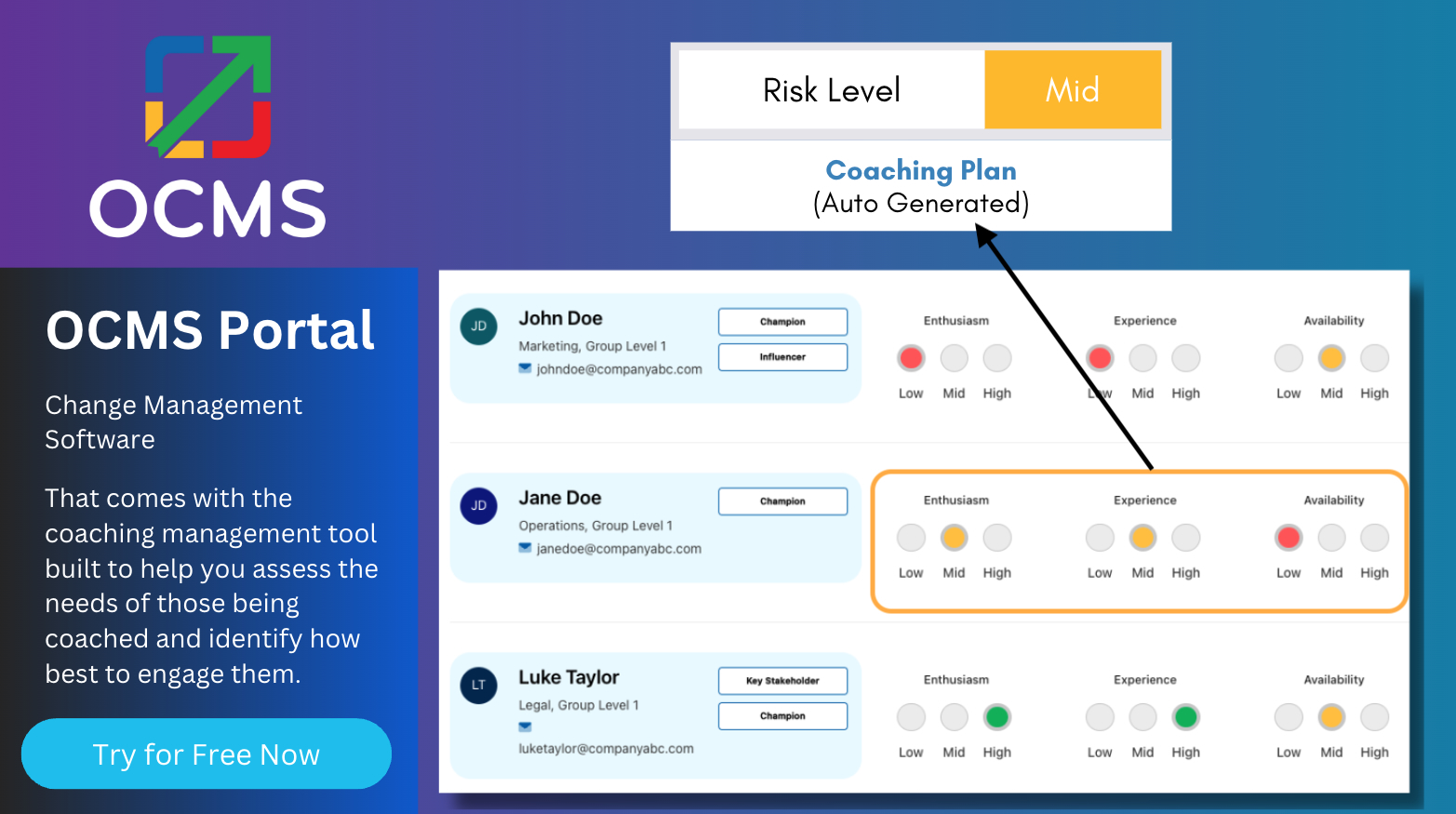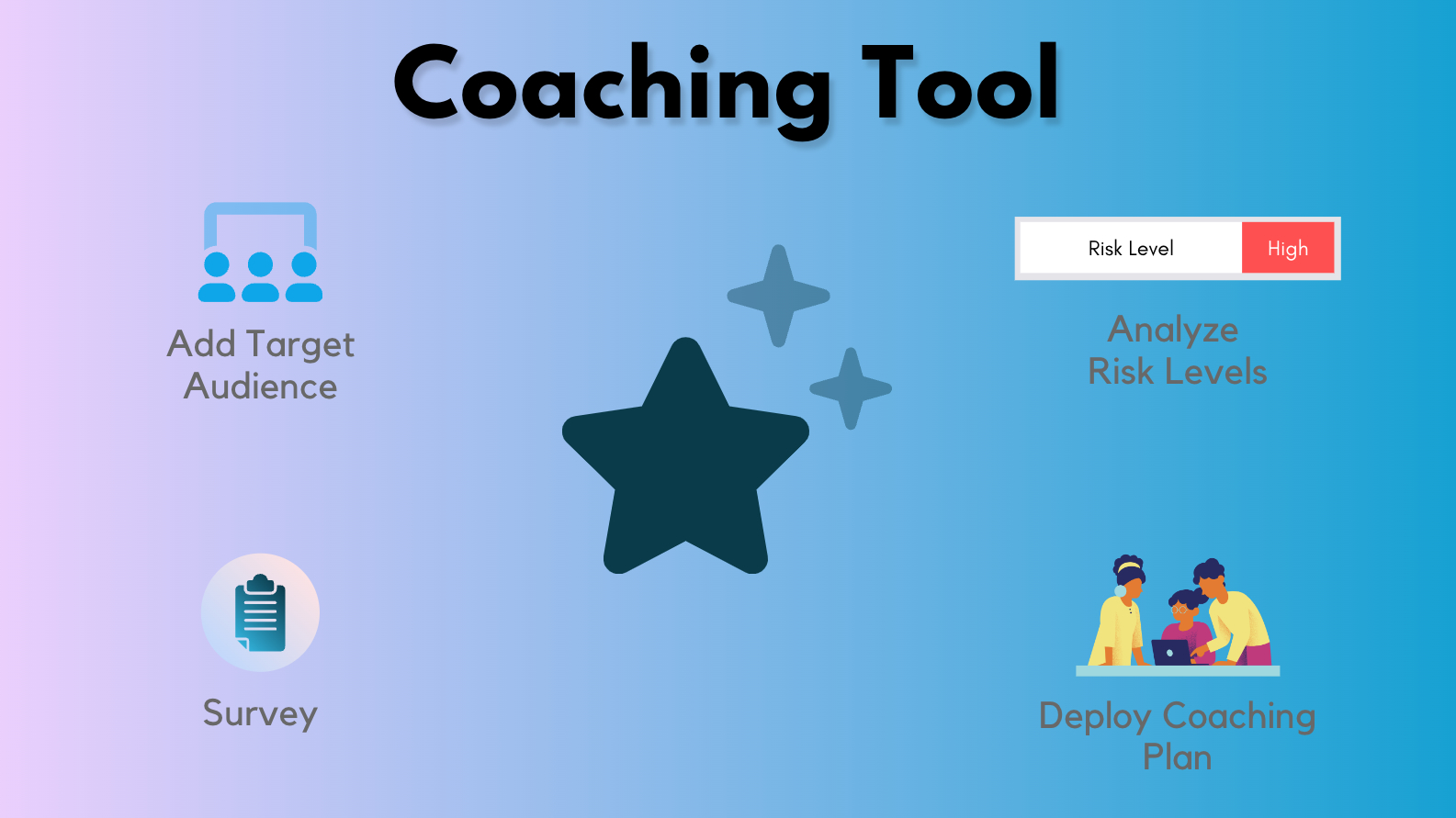The Ultimate Coaching Plan Guide for 2024
 Welcome to our “Coaching Leaders for a Change” guide!
Welcome to our “Coaching Leaders for a Change” guide!
Are you ready to step into the shoes of a change leader, guiding your team through uncharted waters with confidence, adaptability, and resilience? If so, you’ve come to the right place.
In this comprehensive coaching guide, we’ll take you on a journey through the art of leadership in a world that never stands still. Together, we’ll explore the essential strategies, tools, and techniques needed to lead your team through change successfully.
The best coaching plan is one that combines structure with flexibility for coaching individuals, teams, and groups.
Whether you’re a manager responsible for steering your department toward new horizons, an HR professional facilitating change initiatives, or an individual passionate about personal growth, this guide is tailored to help you thrive as a leader of change. So, grab your coaching hat, and let’s dive into the world of coaching leaders for a brighter, more adaptable future!
Are you looking for a summary in a nutshell? That’s up next, but if you’re excited to delve deeper into the most effective coaching strategies? Stick around; we’ve got you covered!
Quick Summary
Coaching Templates: Do They Apply to All Coaching Types?
A coaching plan or template is beneficial for all types of coaching, not just business coaching. Business and executive coaches often use plans or coaching software to track progress. Whether you’re coaching a sports team or providing life coaching, it’s essential to monitor tasks, note mentee progress, identify areas for improvement, and measure coaching success. Using a coaching planning spreadsheet or cloud-based tracking software is helpful for any coaching type to maintain organized and accessible records.
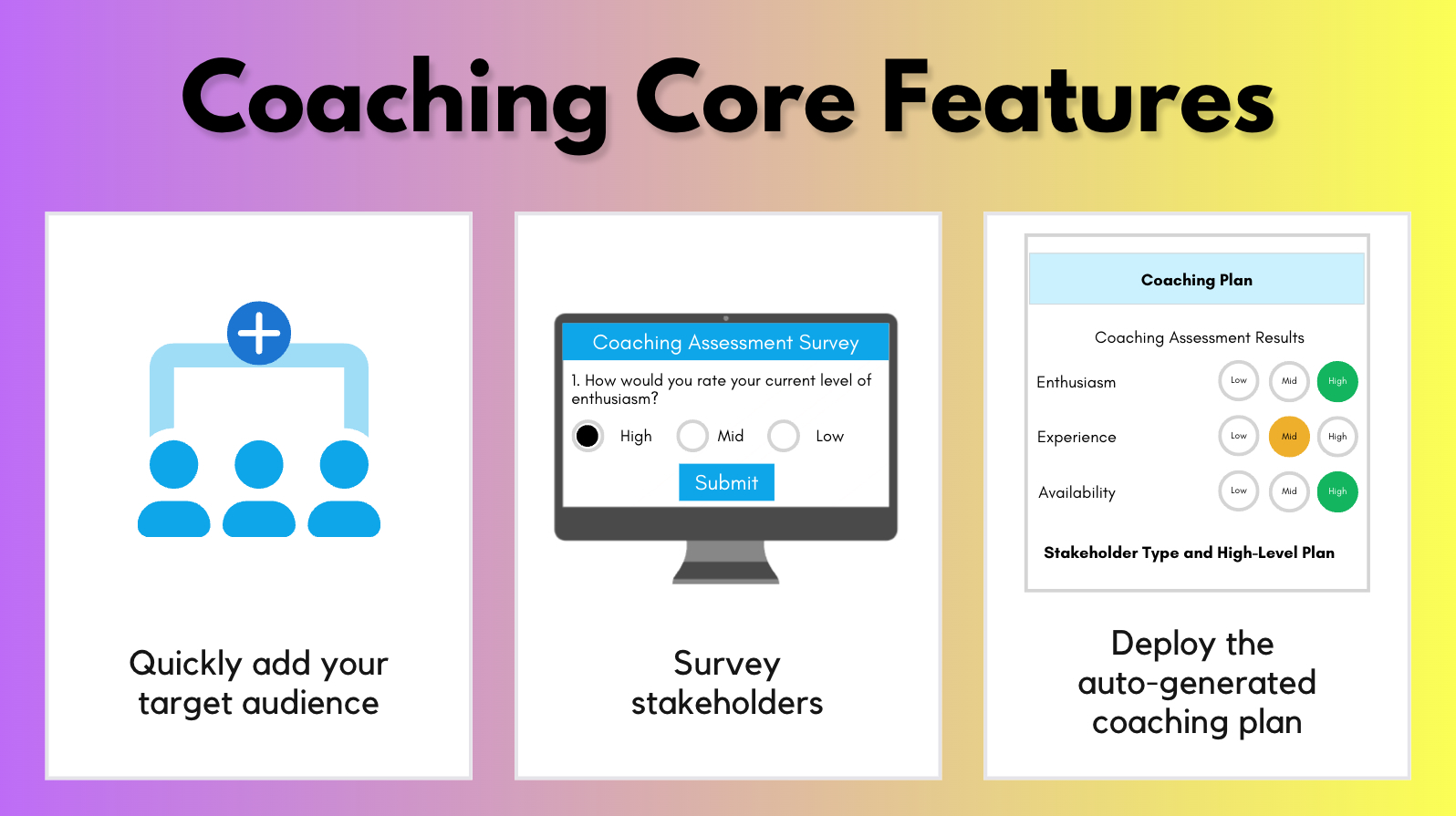
Do you find it challenging to navigate through cumbersome coaching management software? If so, it’s the perfect moment to explore the OCMS Portal. Our comprehensive OCM solution encompasses the Coaching Management Tool, specially crafted to streamline the evaluation and administration of individuals seeking mentorship or coaching. Join us today with a free sign-up, and no credit card is needed.
Elements of an Effective Change Management Coaching Plan
A good Change Management Coaching Plan is centered on facilitating behavioral changes, either by enhancing existing skills or developing new ones. It is an essential component of change management, providing a structured approach, strategies, and activities for coaching business leaders, managers, supervisors, and employees through successful transitions during organizational changes.
When integrating coaching into a project, it typically aligns with specific phases. Using the OCM Solution’s Change Management Framework as an example, coaching activities predominantly occur in Phases 2 and 3. In Phase 2, the coaching plan is developed based on stakeholder and impact assessments, and in Phase 3, the plan is executed, involving coaching for leaders, change agents, users, and others in their roles within the change project.
Different Coaching, Same End Game
Coaching, a blend of mentoring and training, serves diverse purposes across various domains. Its universal goal is to equip individuals with new skills and knowledge. In sports, coaching enhances performance and fosters teamwork. Beyond sports, coaching branches into life, health, and lifestyle coaching, aiming to help individuals adopt better habits to achieve personal goals. In the corporate world, coaching, such as executive and change leadership coaching, plays a pivotal role in performance improvement and project success.
Coaching’s Significance Within an Organization
Coaching within organizations serves a variety of purposes, targeting both internal and external audiences. Examples of these purposes include:
- Facilitating change projects and transformations.
- Fostering leadership development.
- Enhancing the performance of individuals or departments.
- Assisting new employees in adapting to the corporate culture.
- Guiding individuals in transitioning from current habits to new ones.
- Implementing ongoing coaching for change management.
- Equipping vendors with insights into a company’s relationship needs.
- Providing distributors with tips for promoting company products.
- Implementing employee coaching plans to boost workplace performance.
- Cultivating soft skills, such as communication and active listening.
- Establishing a culture of coaching change management to encourage organizational adaptability.
Organizations invest in coaching to empower their personnel with new skills, thereby increasing productivity and positively impacting their bottom line. Leadership coaching, for instance, helps leaders adopt new behaviors, prepare for change, or improve their professional performance.
The OCMS Portal change management All-in-One suite provides the most comprehensive coaching management software among other tools to help with change management success. Try all of this for free (no credit card needed).
Differentiating Coaching for Internal and External Audiences
Coaching in organizations involves working with both internal and external audiences. To manage this effectively, it’s advisable to maintain separate coaching records, whether in Excel sheets or cloud templates, as the information gathered for each audience may vary.
Internal Audience Coaching includes leadership coaching, executive coaching, coaching for change projects, productivity improvement coaching, personal development coaching, and coaching for various offices and divisions within the organization.
External Audience Coaching encompasses coaching for new vendors, new customers, business affiliates, distributors, and franchisees. Each type of coaching serves distinct purposes and requires tailored approaches to address the needs of the respective audience.
Detailed Deep Dive
Top Guide on this Year’s Best Coaching Practices, Plan, Templates & Samples
for Coaching Leaders, Employees, Managers, Students, Individuals, Teams & More
This free coaching plan guide provides you with a step-by-step overview of everything you need to know for effective mentoring and coaching in the workplace and/or outside the workplace. It outlines the best coaching processes with the goal of helping increase your coaching successes.
OCM Solution is a strong advocate and supporter of the coaching and change management communities, and we believe in publishing free guides to help increase coaching capabilities and standardize best coaching practices. Included in this coaching plan guide are best coaching techniques, coaching tips, and a detailed end-to-end coaching process overview.
If you have any questions or feedback, reach out and let us know.
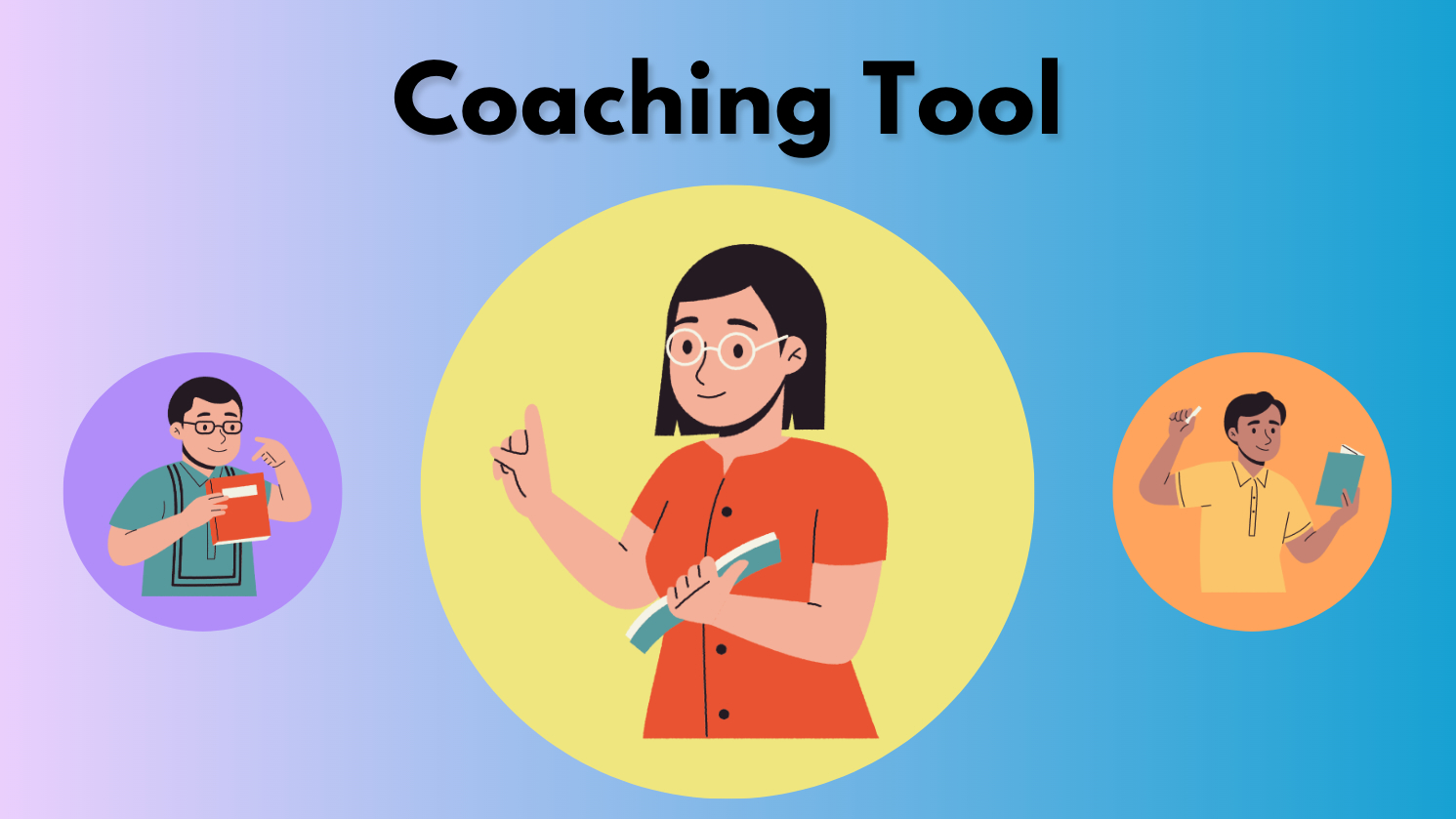
All-in-One Change Manager as Coach Templates
Table of Contents | Best Coaching Guide for Employees, Leaders, Teams, Individuals
Keep on scrolling down this page to read each section or click any link below to go directly to that section.
1. Overview of this Coaching Plan Template Guide
2. Do You Need a Coaching Plan for All Types of Coaching?
3. What is Included in a Good Change Management Coaching Plan?
4. What are the Real Benefits of Coaching?
5. Many Kinds of Coaching, But One Goal
6. Benefits of a Coaching Program Vs. Simple Feedback
7. What is the Purpose of Coaching in an Organization?
8. What Makes a Great Manager? (Top Trait is Being a Great Coach)
9. Who is This Coaching Guide Designed For?
10. What is Coaching in the Workplace?
11. Coaching Plan for Managers – Intro
12. Coaching Plan for Employees & Individuals – Intro
13. Internal Audience Coaching vs External Audience Coaching – What You Need to Know
14. Step-by-Step Coaching Plan for Coaching Managers
15. Step-by-Step Coaching Plan for Coaching Employees & Individuals
16. Step-by-Step Change Management Coaching Plan
17. Conclusion – Change Management Coach
Let us know if you have any questions or comments about coach change management or this change manager as coach guide. Don’t miss: employee coaching template for managers.
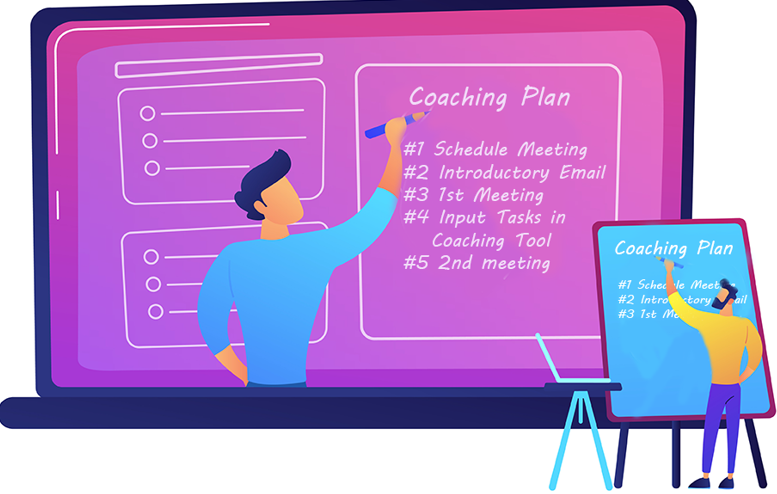
What is coaching? Everything you need to know with employee coaching templates, examples, internal & external templates, and coaching for change management
Overview of this Coaching Plan Template Guide
Effective coaching involves teaching rather than just telling, guiding rather than simply giving someone a list of tasks to do. Good coaching also consists of providing constructive feedback to help an individual grow their skills in the given subject.
Depending on the coaching role and skills you are seeking, this coaching plan guide should meet all your needs. It includes coaching plan examples, insights into the benefits of coaching, a plan for managers and individuals, and organization tips for better coaching management.
According to Forbes, 86% of companies that use a coaching approach feel they have more than recouped their investment.
Many organizational leaders understand that they need to coach their employees and managers to help them develop new skills and/or increase performance, but they lack a true coaching plan that provides them with the best coaching skills, templates, and tools for effective employee, team, and group coaching.

See also: Employee coaching template – one-on-one coaching plan template for managers.
Additionally, many of those who provide student coaching, life coaching, group or leadership coaching may have a general idea of what they need to do, but no tools to help them organize their coaching plan and tasks.
The best coaching plan is a plan that involves a structured, but flexible coaching approach for coaching individuals, teams, and leaders, and that is what this OCM Solution coaching plans’ guide aims to provide to you.
Do you have questions about this coaching for change management guide? Do you have leadership coaching examples or a coaching plan example you would like to see listed in this guide that can help other practitioners? Please reach out and let us know.
Do You Need a Coaching Plan for All Types of Coaching?
Those undertaking business coaching and executive coaching in the workplace often work from a plan or template. It can be using a coaching Excel document they’ve put together or a coaching software to help plan coaching tasks and track the success of the Mentee’s progress.
Do other types of coaching outside the business world need to use a defined and streamlined coaching template?
Yes!
Whether you’re coaching a team of young soccer players or providing life coaching as a consultant, it’s important to keep track of coaching tasks, make notes on how the mentee(s) is progressing, annotate things they may need to work on, and track coaching success.
For any type of coaching, it’s helpful to use a coaching planning spreadsheet or a cloud-based coaching tracking software that you can access from any device.
Illustration – OCMS Portal Coaching Planning & Tracking Template
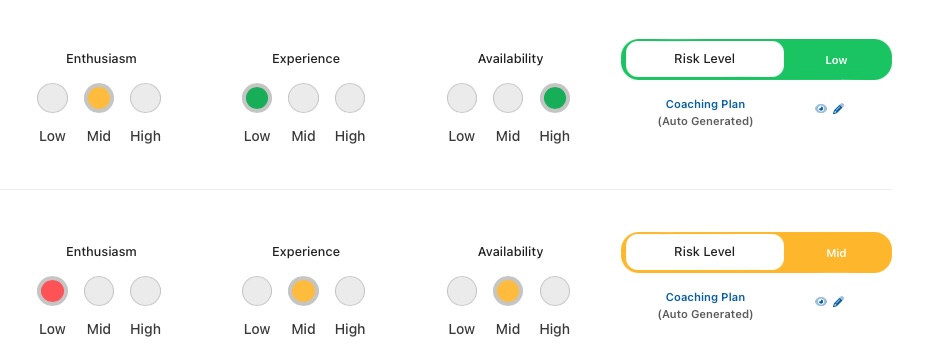
Is there a best coaching plan template for employees that you have used that you would like to share with other project managers and change leads? Please, reach out and let us know.
What is Included in a Good Change Management Coaching Plan?
Any type of coaching involves aiming to change a behavior. You are either trying to improve an existing behavior or skill, or to develop new ones.
In essence, coaching is all about change management.
A coaching plan for change management involves the set of steps, activities, strategies, and approaches that will be used to coach business leaders, managers, supervisors, and employees to help them successfully transition through a change.
Change management coaching also involves working with managers to train them on the best coaching tips and techniques for coaching their employees through a transformational initiative.
And even when you are coaching a team or individuals outside the workplace (e.g., students, sports teams, or more), you still need to apply the same workplace coaching methodology outlined in this guide.
In which phase(s) of your project do you perform coaching with leaders and employees?
If you are following a popular change management and coaching model, such as the OCM Solution Change Management Framework, you’ll find that different change activities are performed at different phases of a project.
For example, the OCM Solution Change Model has five phases:
- Phase 1: Assess
- Phase 2: Develop
- Phase 3: Deploy
- Phase 4: Normalize
- Phase 5: Exit
Coaching is done mainly in Phases 2 and 3.
In Phase 2, you’ll develop your coaching plan, which is going to be based upon your stakeholder and impact assessments. In Phase 3, you’ll be executing that plan, coaching leaders, change agents, users, and others on their roles in the change project.
We provide a detailed review of a change management coaching plan in the sections below – with templates and examples for you to use for your needs.
What are the Real Benefits of Coaching?
Coaching of all kinds is important because it provides a safe space for a person to gain perspective and learn new things that can be applied to their sport, career, and/or lifestyle.
You get a deeper level of learning through coaching than simply being trained because coaching includes mentoring and taking the time to invite feedback and provide constructive assistance to an individual to help them reach a goal.

Change Manager as Coach Templates
Key purposes and benefits of coaching and mentoring in the workplace and outside the workplace include the following:
- Improve individual performance
- Improve team performance
- Increase adoption and acceptance of a business, organization, or technology change
- Effective learning of new skills, new processes, or new systems
- Improve the mentee’s health and wellbeing
- Prepare a person for a career advancement
- Decrease in the tendency of some mentees to exhibit stressful or unproductive behaviors
- Increase in employee morale and productivity
- Successful behavioral changes
- Enhanced employee loyalty
- Build personal awareness
- Provide a roadmap for reaching goals
- and many more
At a firm-wide level, the benefits of coaching and mentoring in an organization involve enterprise-wide cultural receptiveness to change, increase in productivity, and innovation.
The purpose of coaching in the workplace is to increase employees’ and managers’ potential to maximize their own job performance. In a nutshell, coaching in the workplace is the process of providing people with the knowledge, and capabilities that will empower them to successfully change their behavior or learn new life and career skills.
Something to note is that you will need to play the role of change manager as coach when coaching internal audience groups, including executives, managers, etc. A lot of these individuals will not be familiar with the best coaching processes, and will need to quickly adopt new behaviors.
As a change manager as coach, your role is to make the process as easy as possible for them so they can successfully fulfill their responsibilities. Most leaders understand the concept of being good leaders, but it often requires direction from you, the change coach.
Many Kinds of Coaching, But One Goal
Coaching is a general term that refers to a combination of mentoring and training. There are many different coach types and many different reasons for coaching.
Wikipedia defines coaching as: “A form of development in which an experienced person, called a coach, supports a learner or client in achieving a specific personal or professional goal by providing training and guidance.”
While there may be many different types of coaching, they all share a common goal, which is to help the person being coached gain new skills and knowledge.
Most of us can easily understand why coaching is important in sports teams. Players need to understand how to play the game and the best ways to excel.
Team coaching from a performance coach can help players hone their skills and coaching also fosters a sense of community when multiple individuals are coached at the same time.
But sports is just one of the many coach types. Other types of coaching and mentoring include life coaching, health coaching, lifestyle enhancement coaching, and more. This genre of coaching usually involves helping a person become the best they can be by leaving behind unhelpful habits and adopting new and better ones to help them achieve their life goals.
You’ll also find that many organizations employ executive coaching, change leadership coaching, coaching for change management, vendor coaching, and other types of corporate coaching including executive coaching change management as part of a continuous performance initiative or a specific project. We’ll get more into the purpose of coaching in an organization in the next section.
Benefits of a Coaching Program Vs. Simple Feedback
The benefit of a structured coaching program over providing simple feedback on tasks is that coaching for employees, team members, and clients is building that person’s skills today and into the future. It includes follow-up, mentoring, and measurements to ensure mentees are meeting given goals.
Feedback tends to focus on the past and simply provides input on something that has already happened. It doesn’t include ongoing improvement or knowledge-sharing activities.
Coaching for change is forward-looking and focuses on improving the future. It includes feedback but goes beyond that and provides guidance for implementing feedback, invites critical thinking, and promotes an ongoing dialogue between coach and mentee.
For questions about this guide on executive coaching change management best practices, reach out and let us know.
What is the Purpose of Coaching in an Organization?
One of the many types of coaching is that which takes place in an organization. This type of coaching can include internal audiences (leaders, managers, employees, sponsors, Change Champions, executives, etc.) and external audiences (vendors, customers, job applicants, distributors, affiliates, etc.).
Here are examples of reasons for coaching in an organization:
- To facilitate a change project/transformation
- As part of leadership development
- To increase the performance of an individual or department
- To help a new employee adopt the corporate culture
- To transition individuals from their current habits to new habits
- To implement ongoing coaching for change management
- To help vendors understand the relationship needs of a company
- To give distributors tips and insights into promoting the company’s products
- To implement a coaching plan for employees in order to enhance employee and manager workplace performance
- For personal development of soft skills, like communications and active listening
- To implement a culture of coaching change management to facilitate an organization that is receptive to change
Companies invest in coaching for change management and employee coaching plans because they know if their people gain new skills, it helps them be more productive, thus positively impacting the bottom line.
Leadership coaching examples include helping a leader to adopt a new behavior, preparing a leader for a change, or helping a leader improve his or her low professional performance.
If you have questions or input about the OCMS Portal sample coaching plan for employees or coaching template for managers, please reach out and let us know.
What Makes a Great Manager? (Top Trait is Being a Great Coach)
A few years ago, Google wanted to know what made a manager great at Google, and so the company conducted an extensive research study. After surveying, and spending countless hours interviewing employees and firm leadership, below is what they identified as the top traits that made a great manager.
A great manager:
1. Is a good coach
2. Listens, shares information, and is a great communicator
3. Empowers team and is not a micromanager
4. Is productive and oriented around results
5. Creates an inclusive team environment
The research conducted by Google revealed that one of the most important behaviors of top-performing managers was that they were effective coaches.
By going through annual employee surveys and performance reviews, the Google team that conducted the research found that being a great coach was a common behavior across high-performing Google managers.
If you want to empower managers in your organization to be great managers, one of the first steps will be to educate them on how to be great coaches. Don’t miss: coaching template for managers.

Who is This Coaching Guide Designed For?
This change management coaching guide is designed to be used by and for:
1. Change Management Coaching Practitioners
2. Career Coaches
3. Executive Coaches
4. Performance Coaches
5. Human Resources Managers
6. Business Leaders
7. Program Leads
8. HR Leaders
9. Change Manager as Coach Trainers
10. Project Managers
11. Team Coaches
12. Skills Coaches
13. Sports Coaches
14. Personal Development Coaches
15. Life Coaches
16. Employee Relations Managers
17. Change Management Practitioners
18. And anyone interested in coaching roles, techniques, and qualifications.
It can be used by coaching consultants, team coaches, and those who are doing business coaching to support a project or ongoing leadership development. Basically, it is designed to be applied to all coaching types including coaching for change management, for employees, student coaching, executives and leadership coaching, and more.
We also reference OCMS Portal coaching plan templates, tools, employee coaching template, sample coaching plan for employees, and more that you can use for effective coaching for change management, training, and mentoring.
Don’t miss: employee coaching template for managers.
Additionally, many of those who provide student coaching, life coaching, or leadership coaching may have a general idea of what they need to do, but no tools to help them organize their coaching plan and tasks.
If you fall into this bracket, you can check out our All-in-One Coaching Plan, Assessment & Management Software for Coaches
Definitions – What is Coaching?
Before we continue, let us define the various types of workplace coaching, and also provide an overview of what a business coaching plan really is about.
What is Coaching in the Workplace?
Workplace coaching involves mentoring any employees or managers to improve that individual’s job performance or to help that individual successfully coach others, increase productivity, enhance communication, decrease stress on the job, or adopt new business changes and skillsets. Coaching is designed to help make a person better at what they do.
These are just a few examples of why effective coaching is needed in the workplace. There is a wide range of other examples for which you may be seeking to learn more about the best coaching approach and practices.
Coaching Plan for Managers – Intro
A coaching plan for managers is focused on the activities, tips, and steps that need to be taken to increase a manager’s performance or the manager’s effectiveness in coaching their direct reports and employees. Managers are often who employees look to the most for guidance during a change, thus they need to be coached to facilitate a change project.
It’s also often a manager’s responsibility to identify when an employee is ready for leadership coaching to help them move up the corporate ladder to the next step in their career development.
We provide a detailed coaching program for managers in the sections below – with templates and examples for you to use to improve coaching skills for one or more managers within your organization.
Coaching Plan for Employees & Individuals – Intro
Employees and individuals are coached for many different reasons, as explained earlier in this coaching article. They may be receiving executive coaching or skills coaching to improve soft skills, such as communications or public speaking.
Another reason employees are coached is during an organizational change project. It is normal human nature not to like change, especially because developed habits are difficult to break, and employees get accustomed to specific ways of doing things. Some of these habits often lead to poor performance, lackluster skill sets, stress, or difficulties in adopting a workplace change.
And so, developing and executing a multi-pronged employee coaching plan goes a long way towards increasing your ability to successfully implement a performance improvement or business change with one or more employees within your organization.
Individuals who may not be your employees will often use a similar coaching plan. Because no matter the coaching subject, the goal is the same, to impart new skills and knowledge and do so in a way that combines both mentoring and training.
If you’re coaching individuals, you may be providing life coaching, leadership development coaching, coaching for students in a certain subject, or another type of 1:1 coaching.
We provide a top employee and individual coaching template with examples and best practices in the sections below that you can leverage for your needs.
Internal Audience Coaching vs External Audience Coaching – What You Need to Know
If you are coaching in an organization, then there is a good chance you will perform coaching for both internal audiences and external audiences.
It’s a good idea to keep these two audiences in separate coaching Excel sheets or coaching cloud templates, because you may be gathering slightly different information for each one.
For example, when coaching an external audience, you will most likely need to input the mentee’s company name. But if you’re coaching an internal audience, then you would instead be inputting the mentee’s organizational details (division, group, etc.).
Illustration – OCMS Portal Coaching Tool Includes Templates for Both Internal and External Audience Coaching Plans
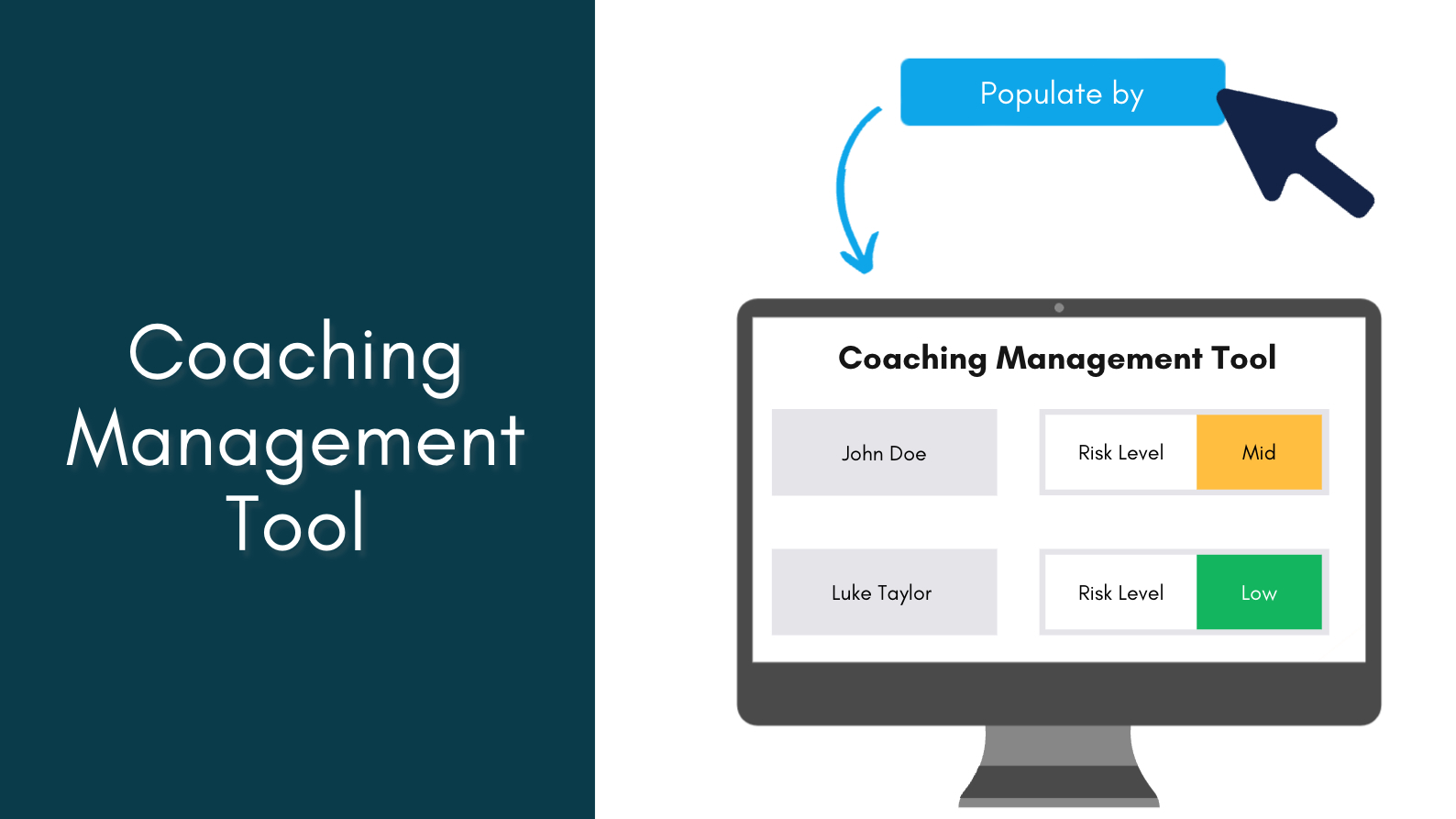
Types of Internal Audience Coaching:
- Leadership coaching
- Executive coaching
- Coaching for a change project
- Productivity improvement coaching
- Personal development coaching
- Coaching for other offices and divisions
Types of External Audience Coaching:
- Coaching for new vendors
- Coaching for new customers
- Coaching for business affiliates
- Coaching for distributors
- Coaching for franchisees
Step-by-Step Coaching Plan for Coaching Managers
This section outlines the coaching program for managers that you can leverage to increase performance and coaching skills for targeted managers.
Coaching Plan Step #1: Identify Managers that Need Coaching
If you are a manager and are looking for a coaching plan to coach your employees, then skip this section and go to the Coaching Plan for Employees & Individuals below. This section is for people that are looking to coach managers.
For those practitioners seeking to train and coach managers, the first step in implementing an effective coaching program for managers is to identify the list of managers that need to be coached.
If you already have an existing list of potential managers and leaders that need coaching, that’s great. In addition, you can follow the steps below to identify more managers and leaders that need to be coached:
- Work with HR or other stakeholders to identify additional managers
- Identify groups with poor employee productivity, low morale, and higher resistance to change. Managers for such types of groups make prime candidates for coaching
- If you have a firm-wide culture change business initiative, then you will want to identify the key managers and supervisors for all impacted groups
- If you know of any groups within your organization that are expressing a tremendous workload, then managers for such groups can also be considered
- Identify any departments that have high employee turnover, for potential manager coaching candidates
We generally refer to all these managers as Mentees.
Coaching Plan Step #2: Enter the Managers’ Information Into a Coaching Database
Enter each managers’ information into a Coaching Template. This is essential as it will enable you to effectively track the implementation and success of your manager’s coaching program.
A coaching template or coaching Excel spreadsheet gives you a place to document coaching tasks for yourself and those being coached. You can also use it to track task progress, receptiveness to coaching, and more.
Sample Manager Coaching Template
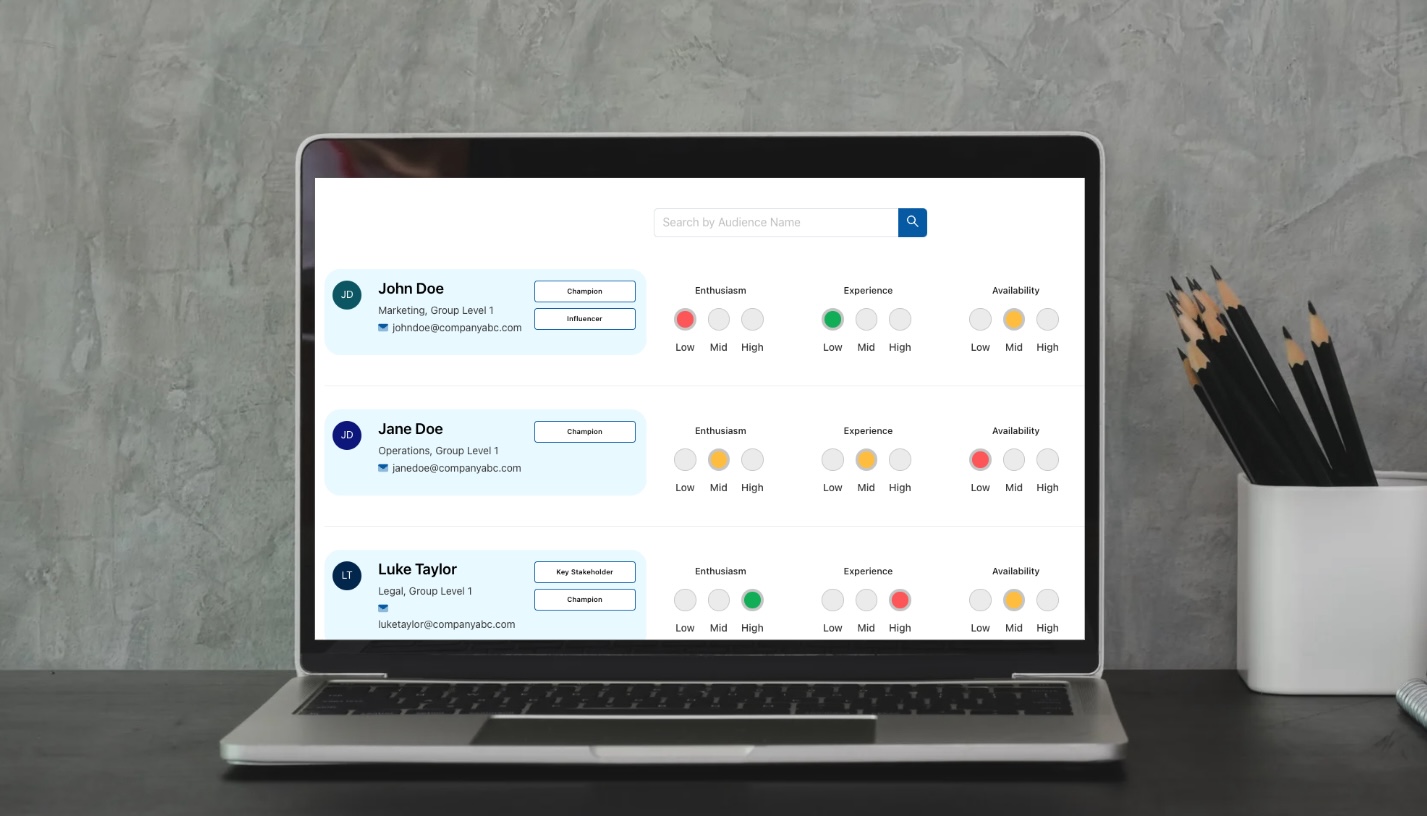
Click below to obtain the OCMS Portal best Coaching Management Toolkit, which includes a streamlined, easy-to-use coaching plan template that you can use to input and analyze information about the managers that need coaching.
This tool is a cloud-based application that is designed to help you plan, manage, and execute a successful coaching plan. Choose from a cloud or Excel version that includes real-time analytics, as well as simplified templates for gathering your coaching information. You’ll also find task management and more in the cloud version!
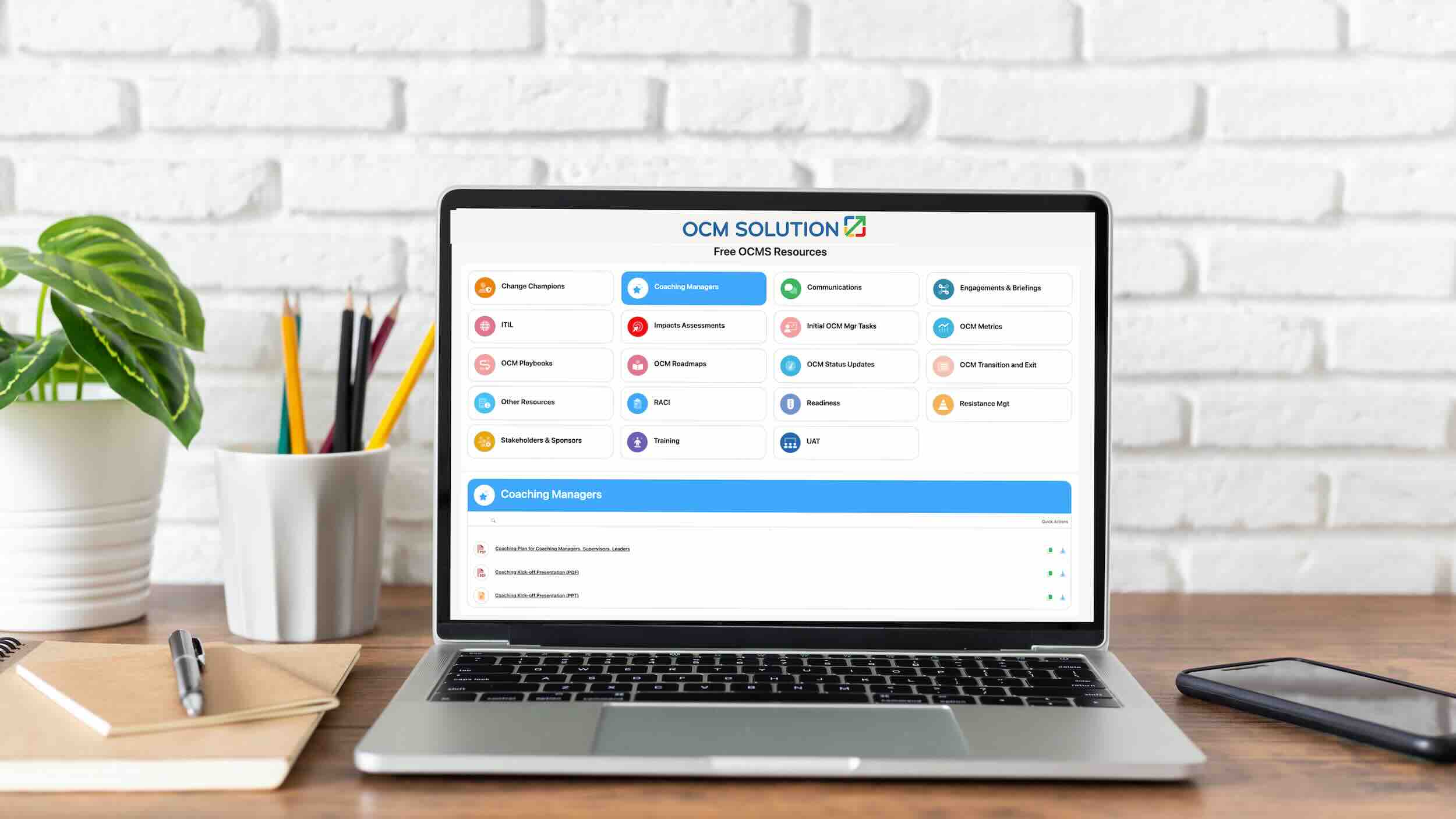
Template for entering and analyzing managers that need coaching
Coaching Plan Step #3: Schedule Initial Meeting with Each Manager Mentee
The next step in your leadership coaching program will be to schedule initial meetings with each manager (Mentee). The goal of this first meeting is NOT to provide coaching. The goal of this initial meeting is a basic “meet and greet” to connect and build rapport.
Start the meeting by setting the expectation that this is just a quick meeting to get to learn more about them, and also to introduce yourself. During the meeting, you can discuss the factors that are driving the need for coaching, as well as the roadmap for which the coaching will be implemented. But it is critical to your coaching success that you don’t use this first meeting to start coaching.
People need to connect with you first on a personal level before they can trust you enough to accept coaching from you. This is why the first coaching meeting is often spent on just building rapport.
When you schedule a meeting with a manager, it is important that you immediately send the manager a heads-up email letting them know that you have scheduled a meeting with them.
Even though the meeting’s agenda information will be included in the meeting calendar invite that you’ve sent, sending a heads-up email is considered a “velvet glove approach.” This approach allows you to start building a connection and rapport even before meeting the person.
Note: If you have already met or are already engaging the person, then you can skip this heads-up email strategy.
Sample
Email Subject:
Hi <Name of Manager> | Heads-up on Meeting Invite I Just sent
Email Body:
Hi <Name of Manager>,
Happy <Insert Day>. Quick heads-up that I just sent you a meeting invite for a quick meet and greet.
I am the <Insert Your Title or Who You are> for <Department or Function>, and I am driving a leadership coaching and mentoring program. The agenda of this first meeting is to introduce myself to you, and also learn a little bit more about you, and answer any questions you might have.
I hope you can accommodate it. Looking forward to meeting and speaking with you.
<Your Name>
<Title>
<Contact Information>
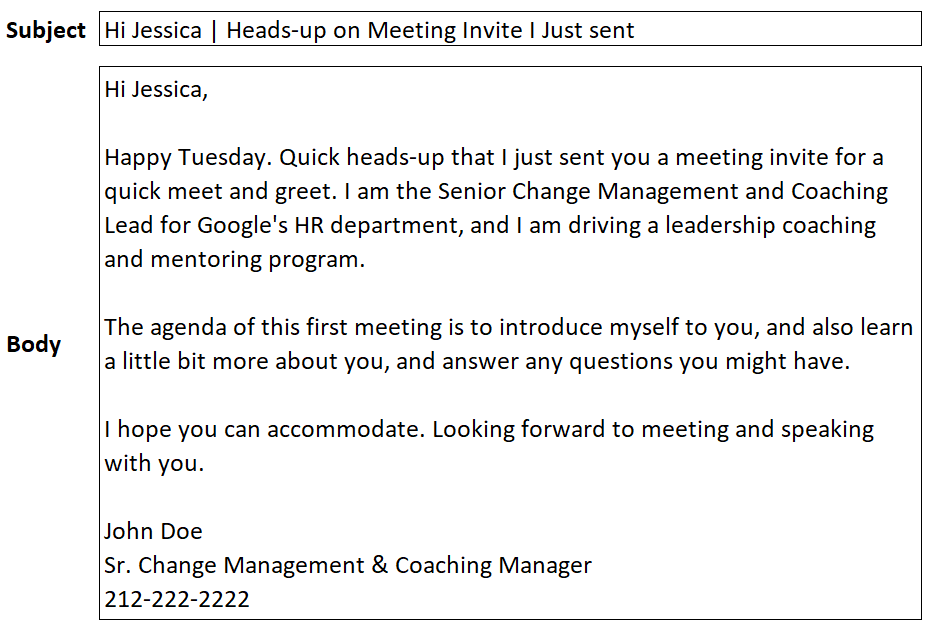
Example of pre-1st meeting coaching email
Coaching Plan Step #4: Conduct First Meeting with Manager (Goal: Meet & Greet, and Provide Awareness)
Sample Meeting Agenda
1. Conduct introductions (if this is the first time you are meeting this person).
2. Provide an overview of the change/program/project/business initiative that is driving the need for the coaching.
3. Provide a brief overview of the key roles that a manager, leader, or supervisor plays during a time of change. More on “key roles” below.
4. Provide an overview of your role as a potential Coach, and how you plan to support the manager during the coaching process.
5. Provide an overview of the importance of coaching and mentoring in the workplace.
6. Ask subtle questions that will allow you to gauge whether the manager is the type that is receptive to being coached or the type that will quickly resist any kind of coaching or mentoring.
7. Get an idea of the availability/bandwidth the person has for the coaching. Ask them for the best days/times in their schedule for coaching sessions to reduce the risk of missed sessions.
For additional agenda topics, check out: OCMS Portal Coaching Tool.
Coaching Plan Step #5: Enter Additional Information Into Your Coaching Template
Based on your initial meeting with the manager and what you have learned about the manager, enter additional information into your Coaching Template including the manager’s receptiveness to being coached, their available bandwidth, and level of coaching activities that will be needed to support this person.
One way that you can gather KPIs is through a survey. Surveys are an excellent way to capture information for your pre-coaching analysis. You can survey Mentees directly or those who supervise the Mentee.
One of the most effective ways to survey those being coached is through an online form tool, such as Microsoft Forms. This makes it easy for users to fill out on any device, and the answers come in instantly, no need to collate several documents that have been received by email.
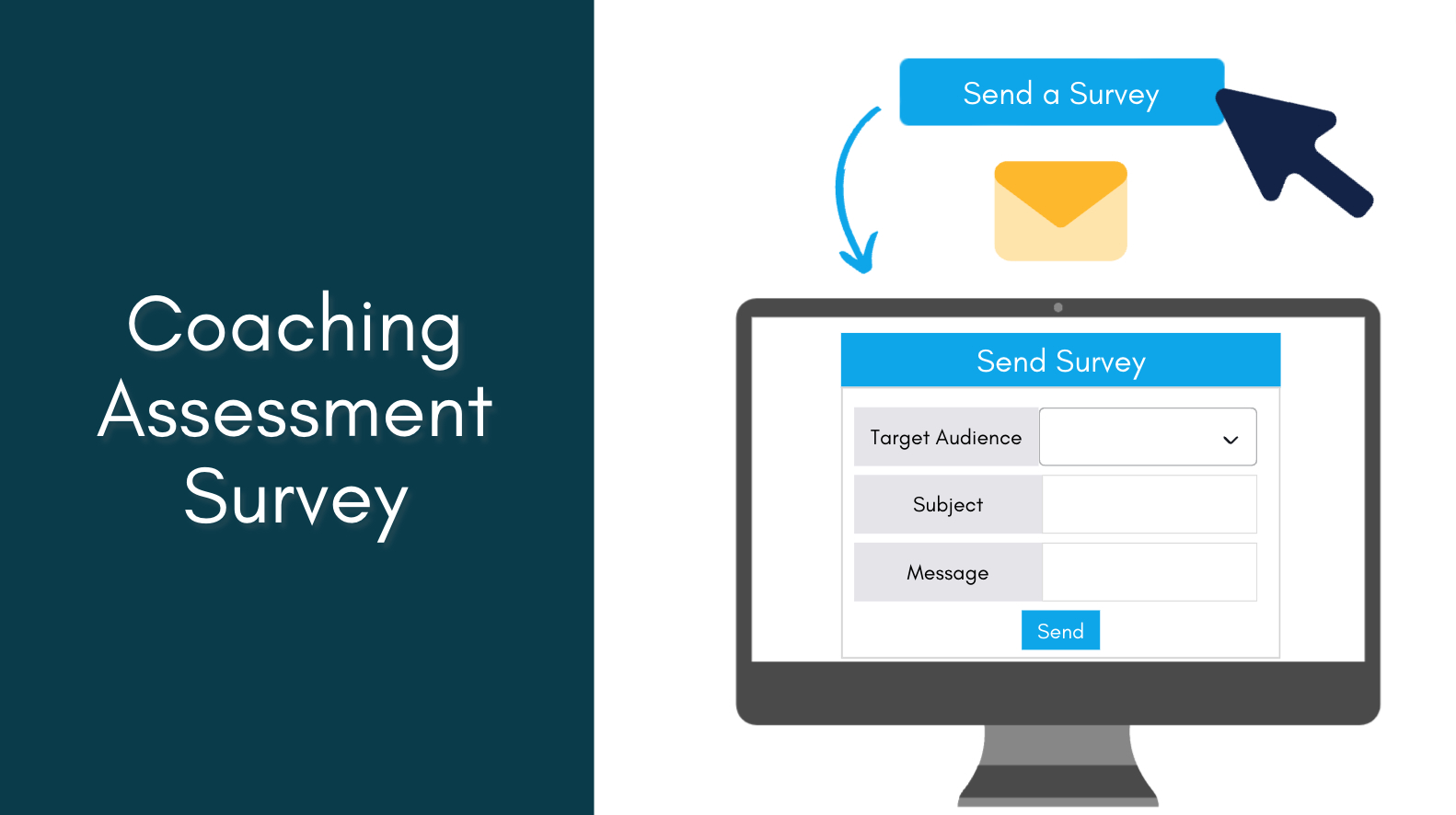
Template for entering and analyzing individuals that will be coached
Coaching Plan Step #6: Schedule 2nd Meeting (Goal: Manager & Leadership Coaching)
The next step is to schedule the second meeting, which will be the first official coaching session for the manager.
The level of coaching provided during this first coaching session (and also subsequent coaching sessions) will depend on the manager’s experience with coaching and also exposure to the topic of the coaching. A manager with little to no coaching experience and one that knows little about the subject of the coaching will require more frequent meetings and support than a manager with some prior coaching skills.
Coaching Plan Step #7: Conduct the 2nd Meeting with the Manager
Implement your manager coaching plan and provide coaching to the manager. During this 2nd meeting, you should focus on the best coaching strategies and tips. If interested, you can obtain our Coaching Management Tool, which includes a detailed step-by-step Manager & Leadership Coaching Guide.

Readiness Guide for Managers and Leaders (Coaching Plan)
Coaching Plan Step #8: Conduct Multiple Follow-ups with the Manager
After your second meeting, you should schedule and conduct additional follow-ups. Coaching leaders is not a one-time exercise. Effective coaching practices involve multiple touchpoints. To ensure that the new behavior/skill is reinforced and maintained, it is essential that you follow up with the coached leaders and managers on a periodic or regular basis to see if they have questions or need additional help/support.
During your 3rd or 4th touchpoint, you will want to discuss an “Employee Coaching Plan” with the manager, if the manager is being coached as part of a leadership training, change project, or executive coaching that will require them to coach others.
This plan will guide them on how to coach their employees and direct reports to increase change adoption, productivity, and to facilitate behavioral changes. See the section below for an overview of the OCMS Portal Employee Coaching Plan, which can also be leveraged for coaching other individuals.
What Types of Things Should You Be Tracking?
Here is an overview of the types of things you’ll want to track during your coaching. Keep these in a coaching Excel or coaching software tool to make your job easier.
Each of these pieces of information will be important for understanding the person you’re coaching, gauging the level of engagement that’s needed, and tracking the coaching progress and success.
Coaching data to track:
- Details of the Mentee (name, title, contact info, etc.)
- Company or organizational department/group, if applicable
- Level of coaching required
- Receptiveness to being coached
- Available bandwidth
- Details on Mentee’s situation (i.e., reason for the coaching)
- Planned tasks & coaching strategy
- The due date for tasks
- Progress of task completion
- Targets/KPI used to measure coaching success
- Coaching success score/level
- Notes on coaching progress
- Tasks being assigned to Mentee and their due dates and progress
Illustration –
OCMS Portal Coaching Template for Planning & Tracking Coaching
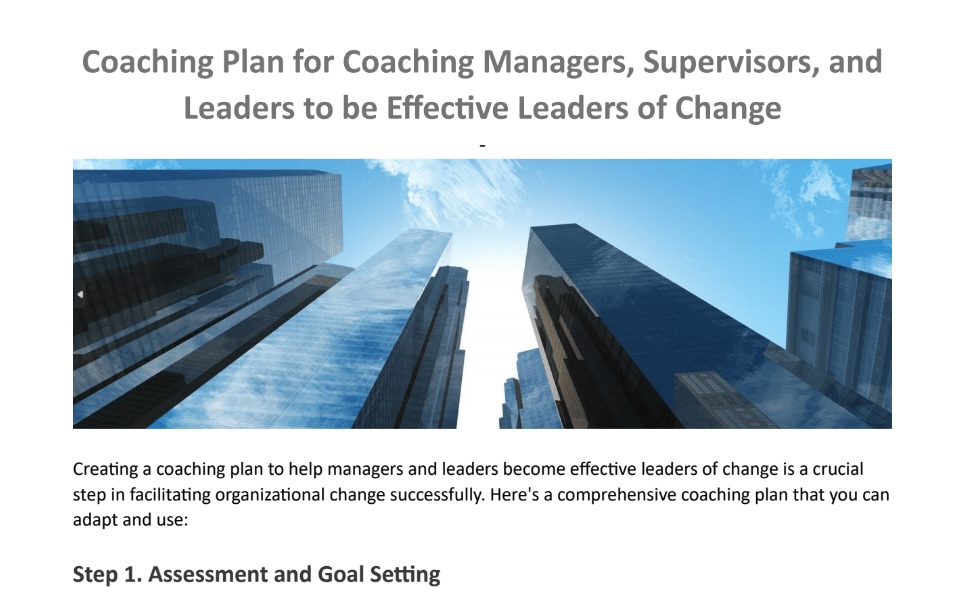
In conclusion, don’t forget to follow up with each manager throughout the implementation of your leadership coaching program, and position yourself as an available coaching resource that they can always turn to whenever they need additional or immediate coaching help.
Such an approach pays huge dividends in the long run as these managers will come to consider you as a valuable resource. And in return, you will be able to depend on these managers to help with future activities and projects, as well as provide coaching to others.
Do you have any questions about the individual coaching plan? Please reach out and let us know.
Step-by-Step Coaching Plan for Coaching Employees & Individuals
This Employee & Individual Coaching Plan section outlines the interactions managers and supervisors can have with their direct reports to help their employees embrace and adapt to change, build new skills, and more.
This plan can also be leveraged for structuring other types of coaching engagements, such as health and lifestyle coaching, student coaching, and more.
The purpose of employee coaching and individual coaching involves increasing performance, adopting new skills and solutions, and enhancing productivity. Read more here: Key Reasons Why Coaching is Important.
Coaching of individuals and employees takes place on two levels:
1. Individual coaching: one-on-one coaching interactions between a supervisor/coach and an employee/individual to guide that person through a learning process.
2. Group coaching: coaching interactions and activities between a supervisor or coach and his or her team
The influence that a leader or manager has on employees is immeasurable for increasing an employee’s acceptance of a change, preparing them for career advancement, and helping them successfully gain new skills.
Engaging effectively with employees during a time of change provides a venue for one-on-one and group meetings between employees and the people they trust the most: their immediate supervisors.
The same is true for other coach types and their mentees/coachees. Individuals being coached develop a respect for their coach that translates into them making gains in part because they want to make their coach proud.
Click below to read about the OCMS Portal Coaching Tool, which includes a detailed employee and individual coaching plan, templates, and also coaching employees examples, and other coaching examples.
OCMS Portal Coaching Management Tool With Employee Coaching Plan for Managers to Use
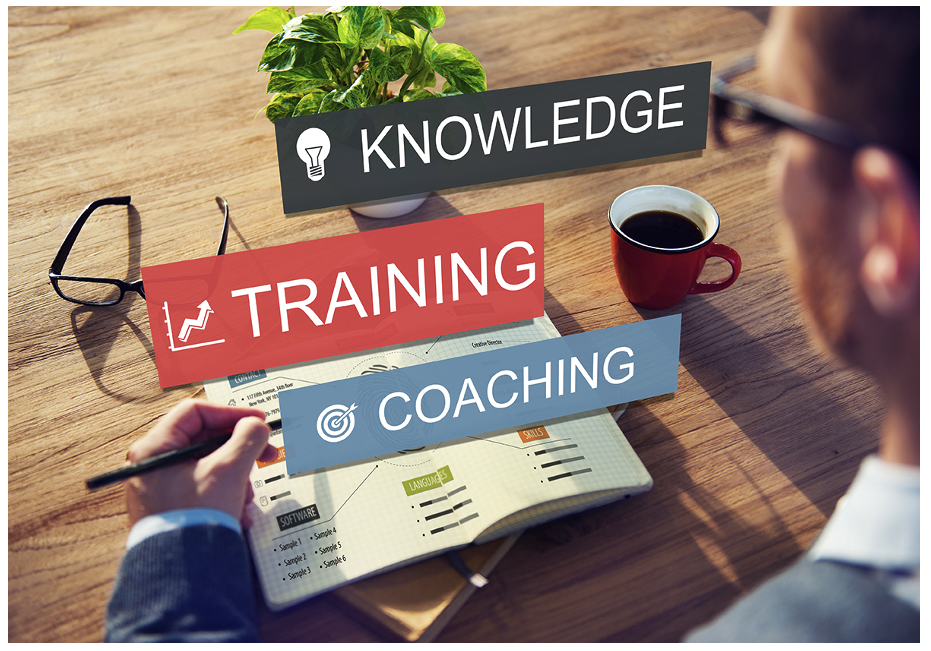
Do you have any questions about the one-on-one coaching plan template? Please reach out and let us know.
Step-by-Step Change Management Coaching Plan
This section is for Organizational Change Management Managers and Project Leads that are implementing a business change, and who need to coach managers.
Apply the change management coaching plan below to effectively coach business leaders, company managers, employees, supervisors, and Change Champions to empower them to be effective agents of change through any type of organizational change.
Change Management Coaching Process:
1. Identify Managers that Need Coaching (Mentees)
2. Enter Mentees Information into Coaching Database
3. Schedule Initial Meeting with Each Mentee
4. Conduct First Meeting (Goal: Meet & Greet and Awareness)
5. Enter Additional Information Into Coaching Database
6. Schedule 2nd Meeting (Goal: “Manager & Leadership Coaching Guide”)
7. Conduct 2nd Coaching Meeting
8. Schedule 3rd Meeting (Goal: “Direct Report / Employee Coaching Plan”)
9. Conduct 3rd Coaching Meeting
10. Conduct Ongoing Touchpoints with Mentees
(Step #1) Identify Individuals that Need Coaching (Mentees)
If you already have an existing list of potential managers and leaders to coach, that’s great. In addition, you can follow the steps below to identify more managers and leaders that need to be coached:
1. Conduct a stakeholder assessment to identify the groups and departments that will be impacted. Managers within these groups will be critical to the organizational change program, and often will need to be coached on being effective “change agents.”
2. Work with program team members (project managers, program managers, leads, and key program resources) to identify additional managers and leaders that might need coaching.
3. Meet with key stakeholders and program sponsors to identify any other potential Mentees.
In general, managers and leaders within impacted organizations, as well as executives, leaders, and managers who are outside of the impacted groups but who are needed to support the program, are all potential coaching candidates. We refer to all these individuals as Mentees.
(Step #2) Enter Mentees’ Information Into Coaching Database
Enter the Mentees’ information into a Coaching Template Database. Click below to obtain OCMS Portal’s All-in-One suite bundled with the Coaching Management Tool that includes a Coaching Template Database that you can use to input and analyze information about the individuals that will be coached.
Our Coaching Tool also allows you to track coaching tasks, tasks for your Mentees, and document important KPIs, such as receptiveness to being coached and level of coaching required.
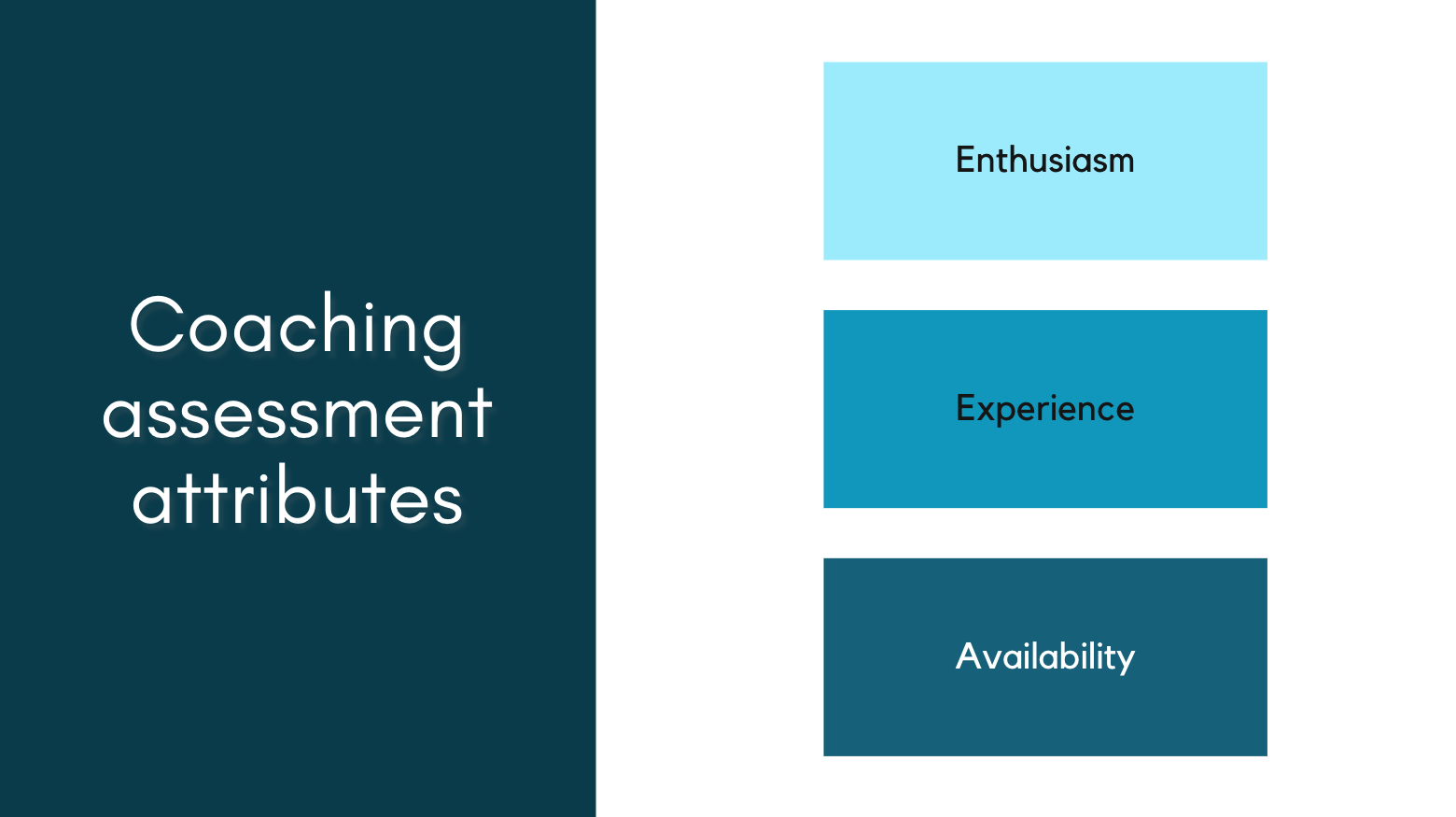
Coaching assessment attributes Template for entering and analyzing individuals that will be coached
(Step #3) Schedule Initial Meetings with Each Mentee
The next step will be to schedule initial meetings with each Mentee. The goal of this first meeting is NOT to provide coaching. The goal of this initial meeting is to “meet and greet”, discuss the business change that is driving the need for coaching, assess their organizational change management (OCM) competencies, as well as their available bandwidth (e.g., how much time they have for the tasks needed), and lastly to discuss the next steps.
It often helps to also send each Mentee a personalized heads-up or a follow-up email letting them know that you have scheduled a meeting with them.
Even though the meeting’s agenda information will be included in the meeting calendar invite that you’ve sent, sending a heads-up email is considered a “velvet glove approach.” This approach allows you to start building a connection and rapport even before meeting the person.
Note: If you have already met or are already engaging the person, then you can skip this heads-up email strategy.
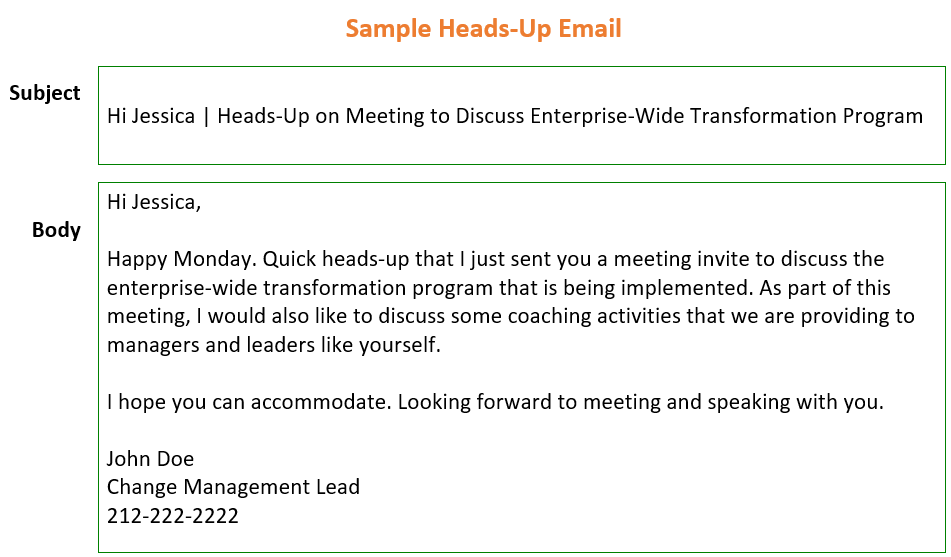
(Step #4) Conduct First Meeting (Goal: Meet & Greet, and Awareness)
Sample Meeting Agenda
1. Conduct introductions (if needed).
2. Provide an overview of the change/program/project/business transformation that is driving the need for the coaching.
3. Provide a brief overview of the key roles that a Mentee (manager, leader, or supervisor) plays during a time of change. More on “key roles” below.
4. Discuss and understand the Mentee’s change management experience and their understanding of best organizational change management practices & methodologies.
5. Provide an overview of your role as a potential Coach, and how you plan to support the Mentee. The level of support will be based on the Mentee’s level of change management expertise and how experienced they are with being change agents during a time of change.
For additional agenda topics, check out: OCMS Portal Coaching Management Tool.
(Step #5) Enter Additional Information Into Coaching Database
Based on your initial meeting with the Mentee, enter additional information into the Coaching Template Database including the Mentee’s receptiveness to being coached, the amount of availability the person has, and the level of coaching activities that will be needed to support this Mentee.
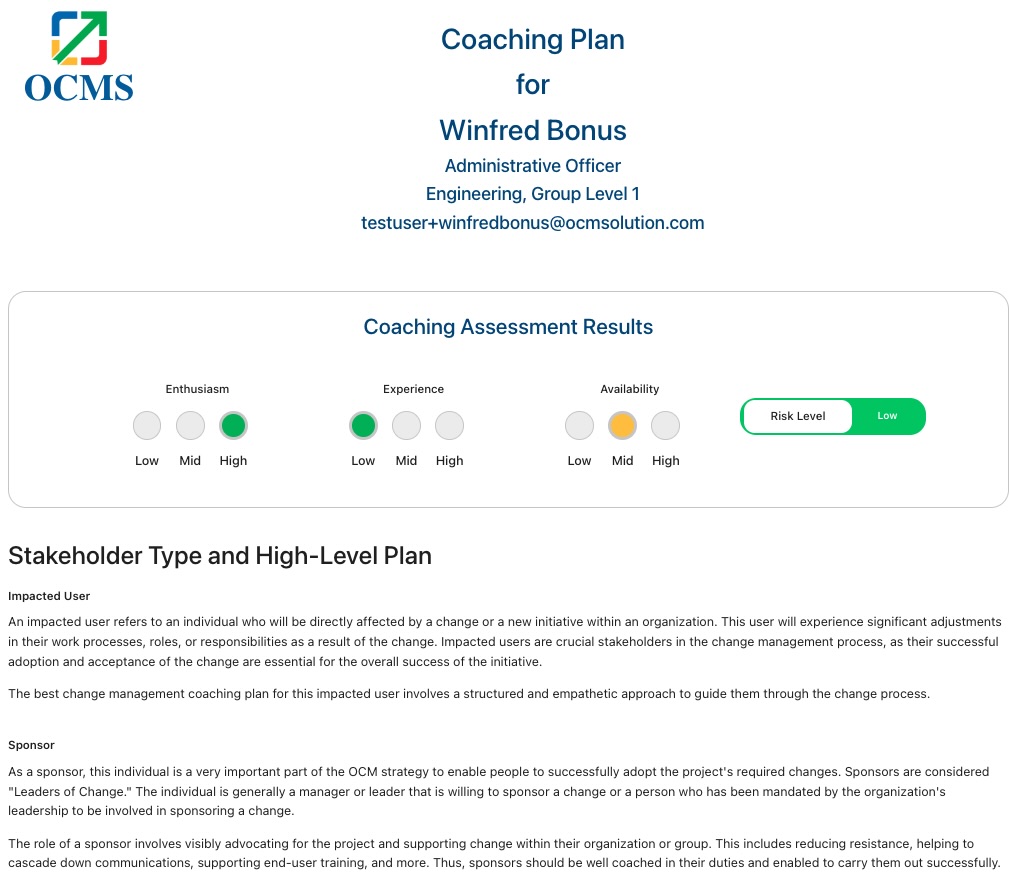
What Types of Things Should You Enter into Your Coaching Tool?
Here is an overview of the types of things you’ll want to track during your coaching. Keep these in a coaching Excel or coaching software tool to make your job easier.
Each of these pieces of information will be important for understanding the person you’re coaching, gauging the level of engagement that’s needed, and tracking the coaching progress and success.
Coaching information to track:
- Details of the Mentee (name, title, contact info, etc.)
- Company or organizational department/group, if applicable
- Level of coaching required
- Receptiveness to being coached
- Available bandwidth
- Details on Mentee’s situation (i.e., reason for the coaching)
- Planned tasks & coaching strategy
- The due date for tasks
- Progress of task completion
- Targets/KPI used to measure coaching success
- Coaching success score/level
- Notes on coaching progress
- Tasks being assigned to Mentee and their due dates and progress
(Step #6) Schedule 2nd Meeting (Goal: “Manager & Leadership Coaching Guide”)
After documenting the Mentee’s level of coaching needed, receptiveness to being coached, and other important information, the next step is to schedule the second meeting, which will be a coaching session.
The level of coaching information shared with the Mentee will depend on the Mentee’s experience with organizational change management best practices. A Mentee with little to no experience will require more frequent touchpoints and support than a Mentee with experience.
(Step #7) Conduct 2nd Coaching Meeting
Implement your detailed coaching plan and provide coaching to Mentees. If interested, you can obtain our Coaching Management Tool, which includes a detailed Manager & Leadership Coaching Guide.
Readiness Guide for Managers and Leaders (Coaching Plan)
(Step #8) Schedule 3rd Meeting (Goal: “Direct Report / Employee Coaching Plan”)
In your 3rd coaching session, you will be introducing the “Direct Report / Employee Coaching Plan” to Mentees, which will guide them on how to approach change management coaching with those personnel that they manage or supervise.
(Step #9) Conduct 3rd Coaching Meeting on Change Management Coaching Plan & Strategy Implementation
During your 3rd coaching session, you should aim to coach the Mentee using the Direct Report / Employee Coaching Plan outlined below. This Direct Report / Employee Coaching Plan outlines the interactions managers and supervisors can have with their direct reports to help them embrace, adopt, and use the target state solutions.
Coaching direct reports and employees takes place on two levels:
1. Individual employee coaching: one-on-one interactions between a supervisor and a direct report to help that individual through his or her change process
2. Group coaching: interactions between a supervisor and his or her team to share key messages about the change
As discussed above, coaching is a vital part of successful organizational change management. Decades of change research conducted by Prosci and other change management research institutions have identified employees, as well as end-user resistance, as a top obstacle to change.
The influence that a leader or manager has on frontline employees and impacted end-users is immeasurable for reducing resistance and increasing end-user acceptance of the change, which is why change and program management practitioners need to implement the best change management coaching plan.
Engaging effectively with end-users during a time of change provides a venue for one-on-one and group meetings between employees and the people they trust the most: their immediate supervisors.
Click below to read about the OCMS Portal Coaching Tool, which includes a detailed employee coaching plan.
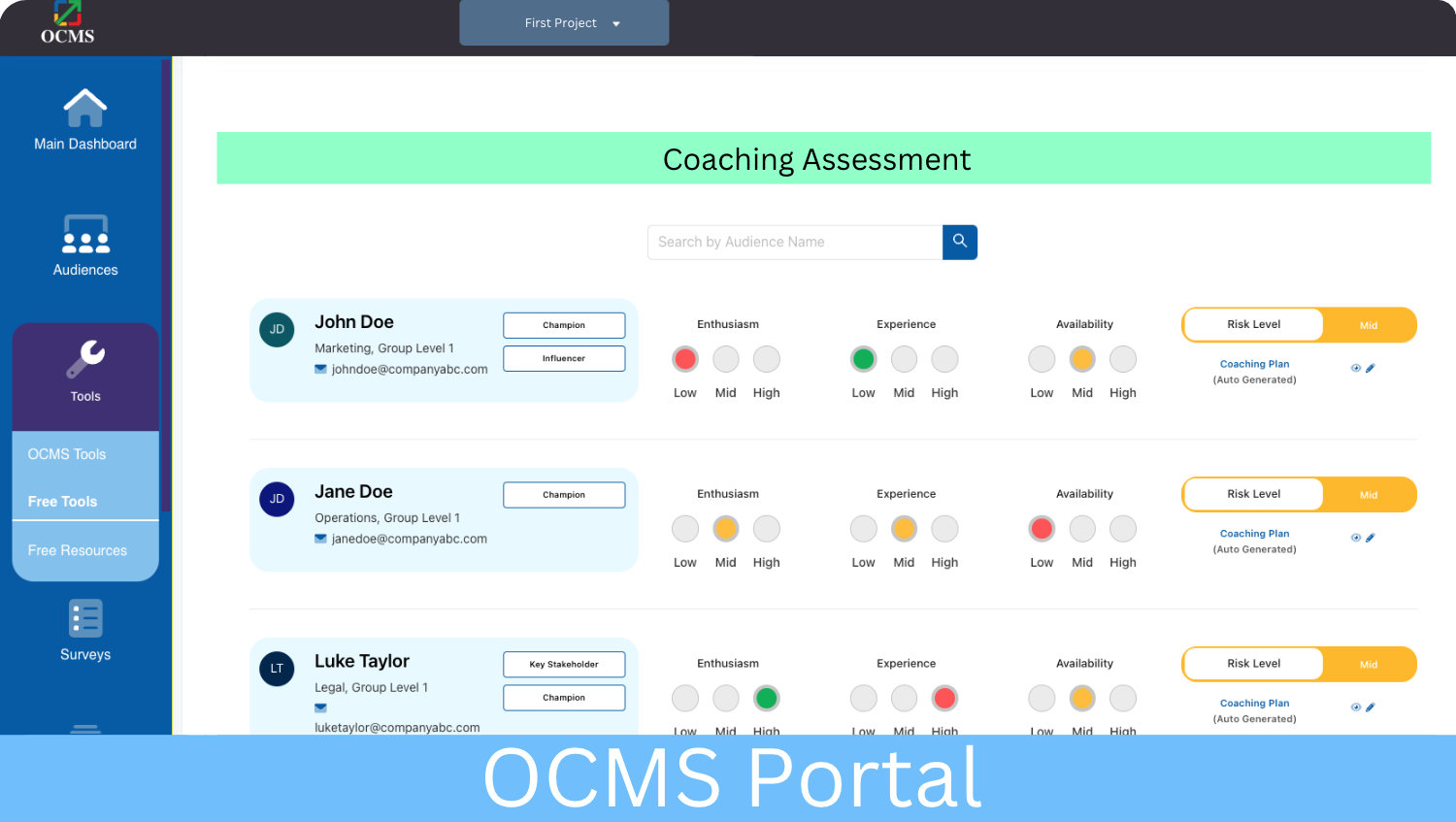
OCMS Portal Coaching Management Tool With Employee Coaching Plan for Managers to Use
(Step #10) Conduct Ongoing Touchpoints with Mentees
Coaching is rarely ever a “one-time-and-it’s-done” exercise. To ensure that the new behavior is reinforced and maintained, it is essential that you follow up with the coached leaders and managers on a periodic or regular basis to see if they have questions or new additional help/support.
Conclusion – Change Management Coach
Coaching managers, employees, and leaders in the workplace is a critical exercise that needs to be conducted to increase the success of an organizational transformation, employee productivity, staff performance, and to help Mentees adopt new skills.
Coaching for other reasons – team coaching, life coaching, health and lifestyle coaching, career development coaching, student coaching – is conducted for similar reasons. The goal is to help individuals adopt behaviors that will help them reach specific goals provided during the coaching activities.
These goals could be to adopt healthier habits, learn how to better manage their life, or learn sports-related skills that will help them improve their performance and success.
As mentioned above, assessing each mentee’s willingness to be coached, the level of coaching they’ll need, and their availability for coaching activities is an important exercise as it allows you to better plan and implement your coaching.
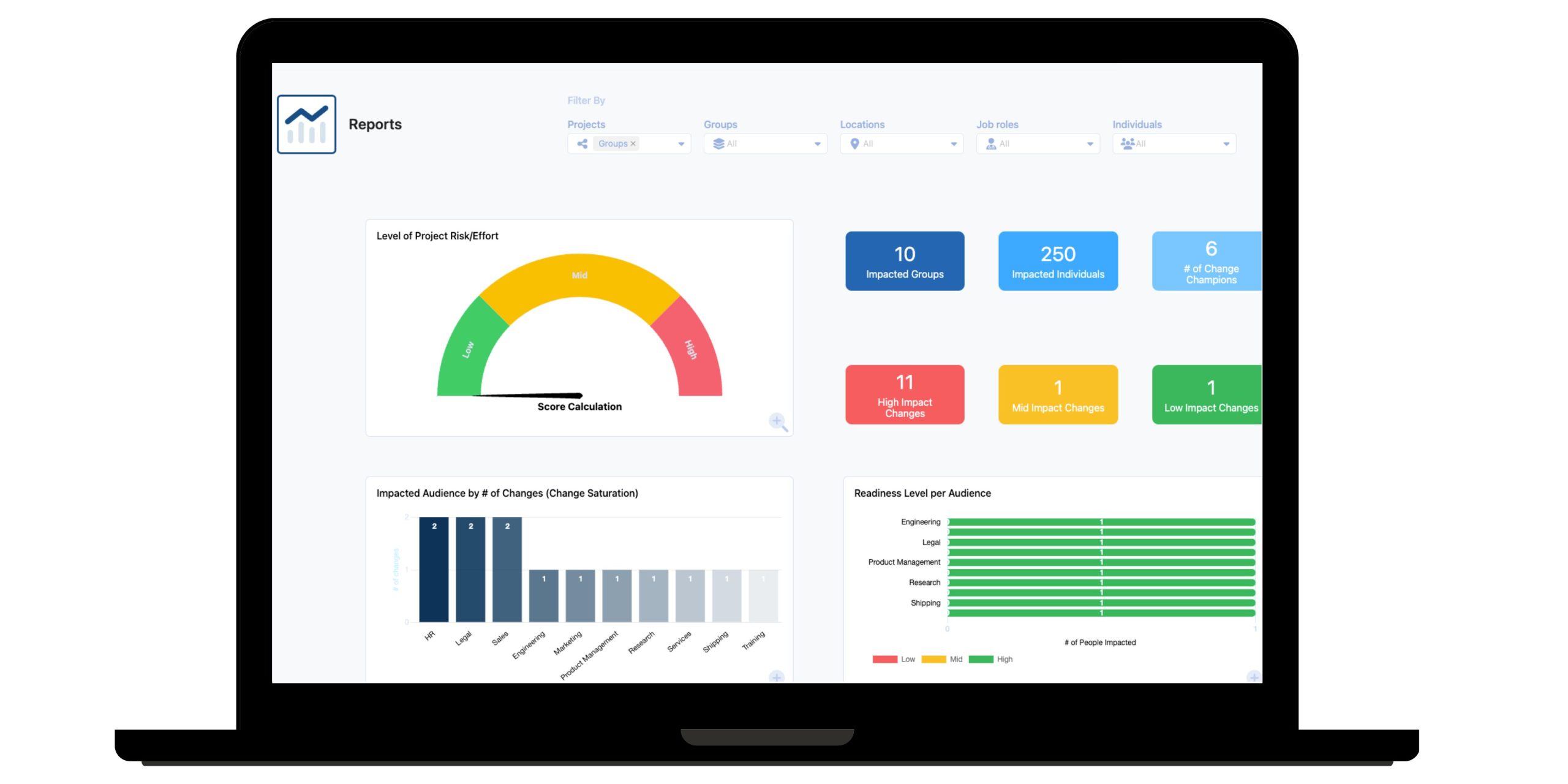
Employee & manager coaching best practices – analytics dashboard
For those Mentees with low- and mid-level competencies, your coaching plan should include an in-person and heavy coaching training strategy. You will want to meet with these Mentees in person (if possible) regularly, and coach them using the leadership coaching plan that you will develop.
You can leverage the information on this page to develop a top coaching plan that best meets your coaching needs. In addition, or alternatively, you can obtain the OCMS Portal All-in-One suite which includes a Coaching Management Tool from OCM Solution providing you with templates, defined coaching plans, task management, and samples.
Illustration –
OCMS Portal Coaching Software Interactive Reports
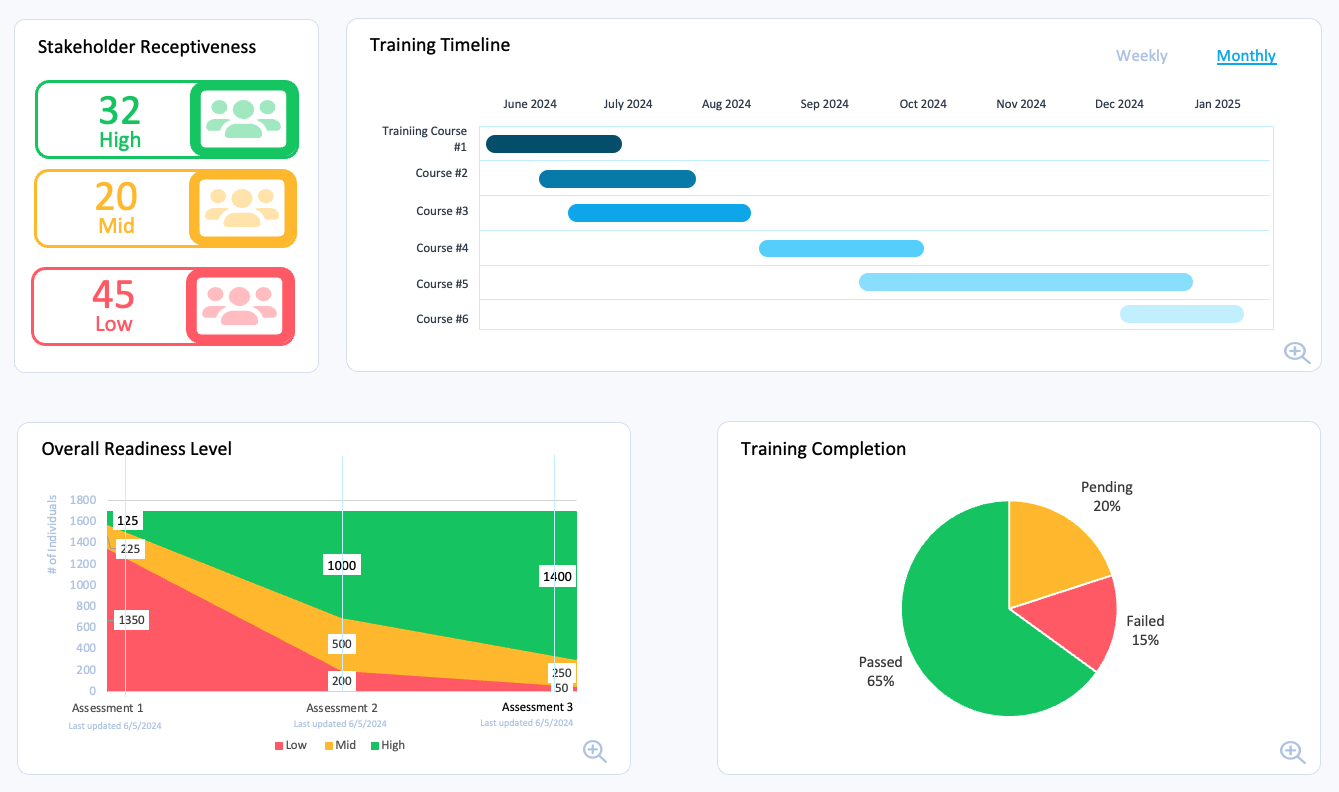
For those Mentees who have a high level of competencies, your coaching plan should involve implementing a light coaching program strategy. Follow up with them periodically to see if they need any additional guidance, support, or additional coaching sessions to boost their skills.
If your coaching activities involve an organizational change, best practices show that a best change management coaching plan should outline the role that the change management practitioner will play. It should also include the strategies he or she will implement to coach and support managers and supervisors during the change.
As mentioned in the early sections of this guide, this coaching guide aims to provide a comprehensive view of team coaching, change management coaching, 1-on-1 individual coaching, leadership coaching, mid-to-senior level supervisor and management coaching, employee coaching, executive coaching, change management transformational coaching for a business change, and other types of coaching. We hope we have achieved the goal of this guide.
If you have any questions about this coaching article, please send me a message. I wish you the best of luck in your coaching activities and efforts, and I hope this coaching guide has been useful to you.
OCMS Portal: Coaching Management Tool
The OCMS Portal Coaching Management Tool includes a best-in-class coaching template, sample data, a 360-degree analytics view of Mentees being coached, coaching surveys to gather KPIs, task management, and much more that you can leverage to simplify and optimize your coaching activities.
OCMS Portal is a full-featured cloud platform to help you plan, manage, and execute a successful coaching project, end-to-end, whether this is your first coaching plan or your one-hundredth. This platform also includes other helpful companion modules such as the Training Management Toolkit, Stakeholder Analysis Toolkit, Communications Toolkit, and more.
Getting Started with Your OCM Solution Coaching Management Tool
If you subscribe to OCMS Portal change management platform, you’ll immediately gain access to the coaching management template and matrix mapping tool, here’s how you get started!
Once you’ve subscribed, you’ll be automatically signed in and be taken to the Main Dashboard page of OCMS Portal. You can find your coaching management tool under “Tools” on the left sidebar then under “Free Tools”.
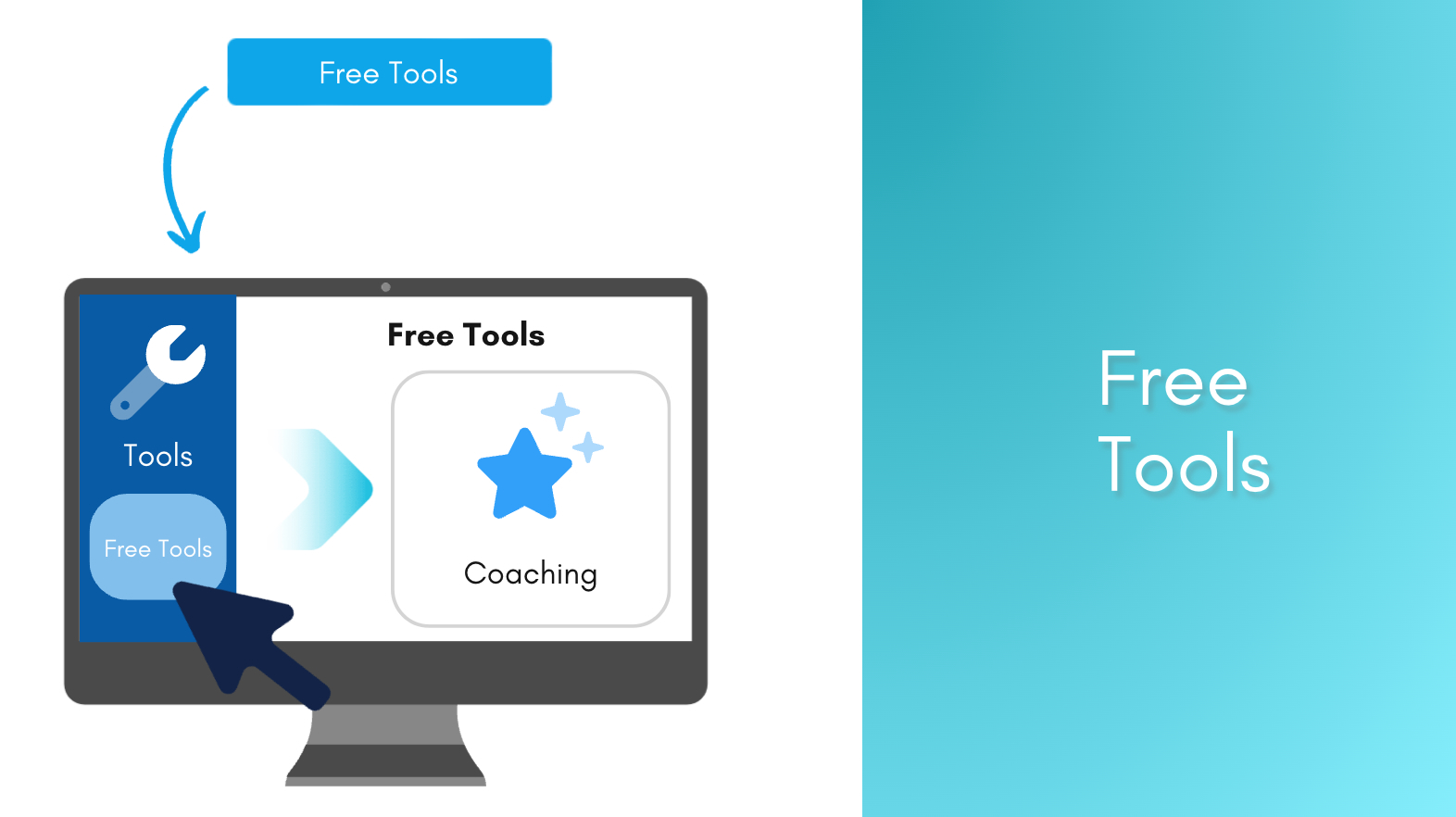
Note that our software includes loads of free change management resources which contains free Coaching Plan for Coaching Managers, Supervisors, Leaders, and a Coaching Kick-off presentation, and much more.
Click below to purchase this tool and for instant access that will allow you to get started right away.
FAQs – Coaching for Change Management, Team, & Individual Improvements
A coaching plan for managers is a plan used to coach managers and supervisors to increase their performance, while a coaching plan for employees is a plan for coaching employees through a change or to adopt new behaviors.
Coaching is the process of mentoring individuals to learn new skills, adopt a change, or to improve performance. Effective coaching helps to increase productivity, decrease work-related stress, and increases how effectively people adopt new changes and skill sets.
The best ways to write a coaching plan is to start with the end objectives in mind including what you want the Mentee or Coachee (the person or group being coached) to get from the coaching. After determining the coaching objectives, the next step is to draft a coaching plan using a multi-prong approach that is outlined in this article.
The purpose of coaching in the workplace is to improve an employee, manager or a group's ability to maximize job performance, increase productivity, change a behavior, or to effectively adopt a new business change.What is a coaching plan?
What is coaching?
How do you write a coaching plan?
What is the purpose of coaching in the workplace?
Note: Content on OCM Solution's ocmsolution.com website is protected by copyright. Should you have any questions or comments regarding this OCM Solutions page, please reach out to Ogbe Airiodion (Change Management Lead) or the OCM Solutions Team today. OCM Solution was previously known as Airiodion Global Services (AGS).
External sources: https://stock.adobe.com, https://pixabay.com/illustrations/coach-tutor-business-mentor-work-407290/, https://pixabay.com/illustrations/consulting-training-learn-knowledge-2045471/, https://pixabay.com/photos/manager-businesswoman-executive-454866/, https://s3.amazonaws.com/images.seroundtable.com/google-my-business-manager-1544444240.jpg, https://www.ls.graphics/free/free-pixel-4-and-pixelbook-go-mockup



